The UK is considering building a large x-ray free electron laser (XFEL) facility on its own that would likely cost over a billion pounds. Scientists met on 30 January at the Royal Society in London to discuss what they want from such a facility, which would start operation in the 2030s if it got the green light from the government.
The meeting launched the £3.2 million UKXFEL Conceptual Design and Options Analysis project, which was announced in June 2022 and runs from October 2022 to September 2025. It aims to look at how to attain next-level XFEL capabilities. That includes new ways of generating x-rays, producing high pulse rates and multicolour x-ray beams that could enable cheaper experiments.
Mark Thomson, executive chair of the UK’s Science and Technology Facilities Council funding agency, decided to drive ahead XFEL discussions when appointed in 2018. This comes after a previous UK XFEL plan, known as the New Light Source project, foundered in 2010 due to the risks associated with it. Thomson tells Chemistry World exclusively that he believes that new XFEL technology will enable new science. ‘I don’t think we’ve yet explored the depth of free electron lasers,’ Thomson observes. ‘I think that’s why this is really exciting.’
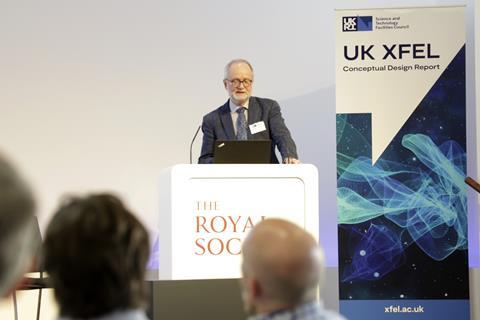
In 2018, rather than developing its own instrument, the UK joined the European XFEL in Schenefeld, Germany by contributing 2% towards the €1.5 billion (£1.34 billion) construction costs. The UK started off paying 2% of the European XFEL’s annual €140 million operating costs, although that figure has now risen to 7%, according to John Collier, director of the UK’s Central Laser Facility in Didcot. That reflects high demand from UK scientists for access to the European XFEL, around 8–9% of its experiments.
The UK’s recent creation of a dedicated government department for science, innovation and technology suggests that it may support spending on a domestic XFEL. However, with otherwise parsimonious policies and a country suffering through a cost-of-living crisis, having an XFEL of its own might appear an unnecessary luxury. Thomson admits that one outcome is concluding that building an XFEL is simply too expensive. ‘Or we might say, well, actually, this looks really exciting, we’ve come up with something that’s genuinely a step forward in XFEL technology,’ he says. ‘In roughly three years’ time, once we’ve done this piece of work, we’ll have to ask those questions.’
Transforming the economics
Thomson adds that beyond the UK going it alone on building an XFEL facility, another option is that an international collaboration could build a new XFEL in the UK. Or the UK could build a test facility as a stepping stone to a larger XFEL. Other options include investing more to support users to go to existing facilities or extending the life of the UK life science and physical XFEL hubs, which help train researchers and prepare samples for analysis at facilities such as the European XFEL. The final option is the UK building facilities located at an XFEL overseas at which to perform experiments
For a new facility to advance XFEL capabilities, perhaps the most critical step forward would be expanding the number of experiments conducted. XFELs are capable of producing x-ray pulses millions of times brighter than pulses from large-scale synchrotron sources and one hundred-thousandth of the duration, lasting femtoseconds. The beams comprise high spectral purity x-rays, mainly travelling coherently in phase with a narrow bandwidth of different wavelengths. This enables x-ray experiments, including diffraction and spectroscopy, to study important chemical processes with exceptional time resolution.
Germany, Switzerland, Italy, the US, Japan, South Korea and China all now have XFELs, with other new sources planned.
The European XFEL is currently running three experimental setups per week, across seven instruments able to receive x-rays at the end of three beamlines. Its firing rate is currently 27,000 pulses per second, or 27kHz. Robert Feidenhans’l, chairman of the management board of the European XFEL, notes that this means that the facility can do around 100 experimental setups per year today. Dividing the XFEL’s running costs equally between setups gives a current price tag of €1.4 million per experiment.
Jon Marangos from Imperial College London highlights that the SLAC National Accelerator Laboratory’s Linac Coherent Light Source (LCLS) XFEL in the US could transform this research output. Its soon-to-open LCLS-II upgrade is set to increase its firing rate about 10,000-fold, from 120Hz to 1MHz. As such the LCLS-II upgrade’s results are essential for the UKXFEL project’s outcome.
Beyond the extra data this would provide, the faster firing rate could transform XFEL economics. The x-ray pulses could be split, or multiplexed, across many experimental stations, for example, with 10 beamlines doing experiments with 100kHz firing rates. That would greatly increase the number of XFEL experiments possible.
Higher pulse rates would also help chemists, says Julia Weinstein from the University of Sheffield. High repetition rate x-ray pulses could allow better synchronisation with other ultrafast sources across the electromagnetic spectrum. If combined with brighter x-rays, this would enable more sensitive experiments, providing signal-to-noise ratios high enough to explore many important and fundamental areas. One example could be studying the intermediate states called excitons that form when photovoltaic cells convert solar energy into electricity. Another could be investigating how materials’ nuclear and/or electron spins behave, which could be important for quantum computing and cryptography.
Dynamic future
Weinstein also envisions high pulse rates and high brightness enabling molecular movies of chemical reactions, capturing bonds forming and breaking and changes of structure and electron density. That would need to combine x-ray diffraction and x-ray spectroscopy with other analytical techniques involving infrared and ultraviolet light and electron beams, and the ability to synchronise these precisely.
High x-ray pulse rates will help capture how proteins move and react, adds Allen Orville from the Diamond Light Source in Didcot, the UK life science XFEL hub’s principal scientist. He recalls one of the first serial femtosecond x-ray crystallography experiments done at an XFEL, published in 2015. It revealed the photodissociation of carbon monoxide bound to myoglobin by spraying tens of thousands of different crystal samples in a jet through the x-ray beam. Careful synchronisation with lasers triggering the photodissociation built up a stop motion movie with sub-nanometre spatial resolution and time resolution of hundreds of femtoseconds. In this way ‘free electron lasers can bring us the opportunity to study function and structure from the same sample and the same x-ray pulse’, Orville says.
This ability to model proteins’ dynamic movements and reactions is currently beyond the AlphaFold structure prediction system from Google offshoot DeepMind, Orville highlights. He also stresses that currently AlphaFold is unable to do many things, including predicting structures bound to ligands or cofactors, meaning that many challenges remain, especially in catalysis. Higher XFEL time resolution would help understand protein dynamics, which AI algorithms will eventually exploit.
For Amelle Zair, head of the attosecond quantum laboratory at King’s College London, a next generation UK-based XFEL would provide a unique opportunity to go to timescales shorter than femtosecond levels, into the attosecond realm. This is where it becomes possible to scrutinise matter at the quantum mechanical level, potentially enabling quantum control of reactions and improving photocatalytic systems, Zair says. This would require very bright attosecond x-ray pulses.
Perhaps surprisingly, XFELs also promise to help study matter at very high temperatures and pressures, explains Emma McBride from Queen’s University Belfast. Most matter in the universe exists in these conditions, she explains, but theories in condensed matter and plasma physics don’t describe them well. ‘We need a really direct and thorough experimental interrogation of this state to understand what things are going on, but also to build a robust and predictive theory,’ she says. Lasers are the only way to heat and compress material to hundreds of gigapascals. Alternately, XFELs can be used to study the extremely short-lived high-pressure states in experiments conducted in diamond anvil cells, including in materials science and chemistry. They can even be used to create extreme states through direct x-ray heating.
Better beams
Meeting scientists’ desires will mean improving how x-ray laser beams are made, with the main approach known as self-amplified spontaneous emission. Researchers are hoping to produce ‘transform limited’ x-ray pulses, meaning that the pulse duration is the shortest possible. Producing beams with high pulse rates usually involves accelerating electrons with superconducting cavities to increase their energy. The beams then pass over an ‘undulator’ of magnets laid side-by-side with their polarities alternating to point in opposite directions. This makes the electrons move side-to-side, emitting x-ray light when they change direction. The electromagnetic fields from the first x-rays help the electrons bunch up and then emit a much brighter, more coherent, x-ray beam.
One option to improve this is to create an XFEL oscillator (XFELO). An XFELO puts the undulator between two mirrors that are only reflective in a narrow range of wavelengths, with some x-rays able to get through one of them. The resulting pulses could be several orders of magnitude brighter than the existing undulator approach and nearly transform limited, comments Patrick Rauer from the German Electron Synchrotron, DESY, in Hamburg. The European XFEL is due to commission an experiment to prove this principle in 2024.
The new approaches should also further reduce the bandwidth of the x-ray pulses’ wavelengths. However, Marangos highlights that there is a trade-off between pulse duration and bandwidth. Attosecond pulses would be relatively broad compared with those lasting hundreds of femtoseconds.
Marangos explains that the UKXFEL analysis process will now involve townhall meetings in different UK regions every three months over an 18-month period from mid-2023 to the end of 2024. The meetings will combine outreach to as many potential users as possible with details on specific scientific areas. Researchers wanting to respond to the conceptual design and options analysis can attend these meetings.
For the scientists attending these meetings, it may be tempting to push for the biggest, most advanced facility possible. But the LCLS XFEL’s director Mike Dunne, notes that beyond building costs, it’s important to factor in running costs, which in his case are around $175 million (£146 million) per year. ‘The last thing you want to do is build a billion-pound facility, and then short-change yourself on exploitation,’ Dunne says. ‘It’s actually better to build a slightly smaller facility and exploit it fully.’
Correction: Jon Marangos’s affiliation was updated on 2 February 2023.





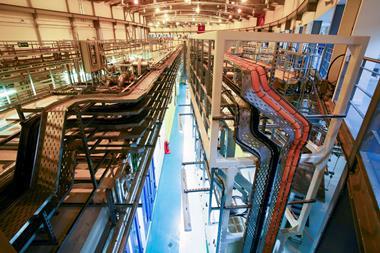

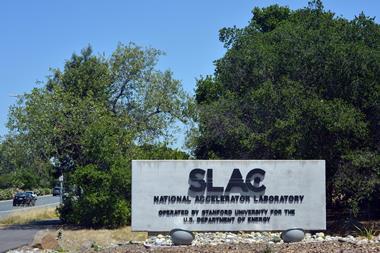
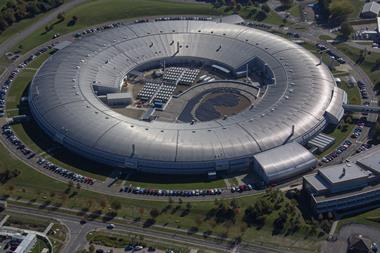
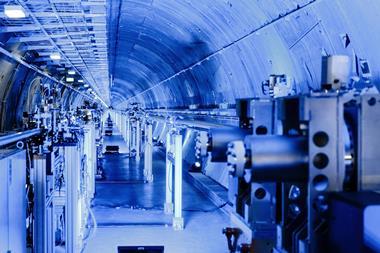







No comments yet